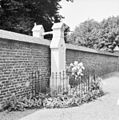Grave with the little hands
Graf met de handjes | |
 | |
 | |
| Coordinates | 51°10′53″N 6°0′0″E / 51.18139°N 6.00000°E |
|---|---|
| Location | Cementery Nabij Kapel in ’t Zand, Roermond, the Netherlands |
| Material | limestone,[1] sandstone, hardstone[2] |
| Completion date | probably 1888[3] |
| Restored date | 1972,[3] 2015/2016[4][1] |
The monument Van Gorkum-Van Aefferden, more well known as the "grave with the little hands" is a monumental Tombstone in the Dutch city of Roermond.[5]
Background[change | change source]
The cemetery that holds the monument was originally a Jewish cemetery but in the late 18th century, the owners of the cemetery allowed Dutch people of other religions to be buried there. In 1858, the artist Pierre Cuypers redesigned the cemetery making different sections for people of different faiths or sects.
The tomb was created for a Catholic woman and a Protestant man who were Jacobus Warnerus Constantinus van Gorkum (Van Gorkum) and Josephina Carlina Petronella Hubertina van Aefferden. Both were married to each other besides their differences in religion, social class, and age. This caused a huge ruckus over their love and marriage which was condemned by many. After Gorkum's death, he was buried in the Protestant section of the cemetry. His widow wanted to be buried next to her husband but she could not be buried next to his husband due to the religious differences. The solution to the problem was to create a double grave on both sides of the wall with two hands connecting the graves.[6][7]
Description[change | change source]
The grave monument contains two identical tombstones on both sides of the wall. Both tombs are placed on a limestone base, and are made of sandstone. Both are also crowned with the coat of arms of the Van Gorkum family on one side and a alliance coat of arms on the other side. On the back of the tombstone, hands are depicted of a man and woman trying to reach other besides their religious differences.
Both graves are locked off from being entered using iron bars to prevent trespassers from entering.
Pictures[change | change source]
-
Black and white picture of Gorkum's wife's grave
-
Gorkum's grave
-
Gorkum's wife's grave
National Monument Register Status[change | change source]
The double grave was added to National Monument Register in May of 2002 as it was seen to have held cultural value due to both of them wanting to be connected despite their religious and cultural differences. The monument was added because of its unique design choices, its unique choice of materials, and finally its ornamentation.[5]
References[change | change source]
- ↑ 1.0 1.1 Mathijs, Armand. "Graf met de Handjes -Grave with tiny hands". Retrieved 5 March 2024.
So yes, I'm proud that I did the restoration of this iconic grave. The headstone of the grave of the colonel and the hands that connects the two stones were carved in a similar limestone last year.
- ↑ "Rijksmonumentenregister:Tegenover Weg langs het Kerkhof 1, 6045 AN te Roermond" [National Monument Register: Opposite Weg langs het Kerkhof 1, 6045 AN in Roermond]. cultureelerfgoed.nl (in Dutch). Rijksdienst voor het Cultureel Erfgoed. Retrieved 5 March 2024.
- ↑ 3.0 3.1 "Restauratie 'graf met de handjes'" [Restoration of the 'grave with the hands']. oudekerkhofroermond.nl (in Dutch). Stichting Oude Kerkhof. Retrieved 5 March 2024.
Het befaamde 'graf met de handjes' dateert waarschijnlijk uit 1888.
- ↑ Tückmantel, Ulli (18 November 2016). "Totensonntag: Die Liebe eines Ehepaares: Was aber Gott verbunden hat. . " [The Love of a Married Couple: What God Has Joined Together . . .]. Westdeutsche Zeitung (in German). Retrieved 11 March 2024.
- ↑ 5.0 5.1 "Tegenover Weg langs het Kerkhof 1, 6045 AN te Roermond | Rijksdienst voor het Cultureel Erfgoed". monumentenregister.cultureelerfgoed.nl. Retrieved 2024-02-05.
- ↑ Nederland's Adelsboek 38 (1940)
- ↑ Nederland's Adelsboek 38 (1940)



